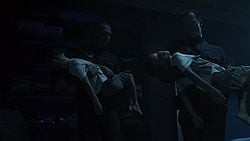Flash cloning: Difference between revisions
From Halopedia, the Halo wiki
Lord Susto (talk | contribs) mNo edit summary |
Lord Susto (talk | contribs) m (→Gallery) |
||
| Line 17: | Line 17: | ||
File:Daisies - Homecoming.png|[[Daisy-023]] facing her flash clone. | File:Daisies - Homecoming.png|[[Daisy-023]] facing her flash clone. | ||
File:1771882-gallery.png|Concept art of Daisy-023's flash clone. | File:1771882-gallery.png|Concept art of Daisy-023's flash clone. | ||
File:flashclones.jpg|Sketch depicting Dr. Halsey's malformed clones. | |||
</gallery> | </gallery> | ||
==Sources== | ==Sources== | ||
<references/> | <references/> | ||
[[Category:Medicine]] | [[Category:Medicine]] | ||
[[Category:Human technology]] | [[Category:Human technology]] | ||
Revision as of 18:24, May 4, 2013
Flash cloning is a human medical process used to clone body parts. The process uses a sample of a human's DNA to grow a cloned organ, which can then be transplanted into the subject who contributed the DNA sample. Usually, the organ is programmed to grow at an accelerated rate and cease rapid development when transplanted into the subject. This makes the method viable in urgent situations, where patients can't afford to spend years waiting for a normal organ to develop. Since the transplanted organ's DNA matches that of the recipient, the risk of transplant rejection is completely eliminated.
Human cloning

While flash cloning entire humans is possible, the procedure is by no means perfect, and unauthorized cloning is illegal in accordance with UN Colonial Mortal Dictata. The process involves the modification of a cloned human embryo, which causes it to develop one hundred times faster than it would have naturally. Many anomalies appear as a result of this abnormal development rate -- they lack the muscle memory and socialization of their hosts. Though these problems can be remedied with intensive therapy, the worst flaw in flash-cloned humans -- compounding biological defects -- cannot be corrected. Rapid flash cloning of such immense volumes of tissue induces gross DNA base-pair errors; congenital defects increase 42 percent and incidents of Parkinson-plus syndromes increase 67 percent. Although a small percentage of flash clones can have a normal life expectancy, most flash clones will start to degenerate from metabolic instability as part of a process called "metabolic cascade failure" - death from various neurological and physiological disorders. The average half-life of a flash clone is 14.7 weeks in laboratory conditions.[1]
Dr. Catherine Halsey developed and perfected a technique through which a living person's memories can be transferred to a flash clone's brain, thus creating a clone that is virtually identical to their original host. This process used a "Fast Fourier Transform X-ray 3-D scan" to map a brain's ionic density patterns. This data could then be used to create a virtual map of every individual link in a brain's neuron pattern. This data would then be used in a deep-stimulating scan of a flash clone's "blank" brain, which would cultivate an identical pattern of linkages and accurately replicate the memories of the host person.[1] Unfortunately this memory replication results in an 82 percent rate of dementia, schizophrenia, and cancers in the recipient brain.[1]
This technique was used to create identical clones of the SPARTAN-II candidates, which replaced the children after the candidates were abducted from their homes. Most of the flash clones quickly died natural deaths, which were explained as pre-existing genetic disorders,[2] drawing suspicion away from the Office of Naval Intelligence. Contrary to Halsey's expectations, many of the clones lived far longer than previously estimated based on laboratory conditions,[1] with at least four surviving until 2525.[3] Halsey's attempt to cover up the SPARTAN-II program's use of flash clones, (as well as her allegedly selfish motives for using the clones), contributed to her detainment by ONI after the Human-Covenant War.[4]
Usage for creating AI
Because humanity is a Tier 3 civilization and the creation of a "smart" AI requires the destruction of a human brain, the brain of a deceased person is used. There is one known exception however: Cortana was modeled after a flash clone of Dr. Catherine Halsey's brain. Halsey used the same mothballed equipment used to clone the Spartan candidates to create twenty clones of herself, however she enhanced the neural physiology at the expense of the rest of their bodies, leaving them seriously malformed.[1] Only one clone brain survived, which was then used to create Cortana. Three specimens were placed in cryogenic suspension until a future time when technological advancements made Halsey's plans for them possible. The use of a clone and memory transfer allowed the UNSC to provide a brain used for the mapping of the AI's "mind" with no undue effects on the donor.[5] Despite this advantage, the cloning of a human being, particularly for this purpose, is highly illegal and unethical.[1]
Gallery
Daisy-023 facing her flash clone.
- 1771882-gallery.png
Concept art of Daisy-023's flash clone.
Sources
- ^ a b c d e f Dr. Halsey's personal journal
- ^ Halo: Glasslands, page ???
- ^ Halo Legends - The Package
- ^ Halo: Glasslands, pages 346-352
- ^ Halo: The Fall of Reach, page 18

